Overview
The CMI Shorti ascender series appeared in 1979, along with the 5000. The design evolved as time passed, and there were four named versions, sensibly called the Shorti, Shorti II, Shorti III and Shorti IV.
All four versions had a frame milled from an aluminum alloy extrusion, with triangular attachment points above and below the cam. These frames are nearly indestructible under normal use and realistic abuse.
All Shorti versions featured a safety that was mounted in a slot in the cam, with a finger tab above the cam used to actuate the safety. We will see that there were two major versions of the safety. Both were awkward to use. The ascenders can be opened with one hand, but not easily, particularly when used in the "wrong" hand.
Let’s look at the differences among the four versions:
SHORTI (1979-80)
The easiest way to recognize a Shorti is to see an anodized frame with that the triangular attachment points are on the cam pivot side of the ascender, away from the rope channel. The location of the attachment points leads to substantial ascender canting each time it is loaded; this results in some efficiency loss while climbing. This was a major design flaw that was corrected in the Shorti II, III, and IV.
Viewed from the front, the Shorti has a rectangular rope channel.
The Shorti safety is a nylon elbow that extends above the frame. This is design is shared by the Shorti II.
I have three versions of the Shorti. In the first, the cam spring has a long tail that extends nearly to the bottom of the ascender. This was ridiculous; the long tail could catch on things and get damaged. The next version shortened the tail so that it did not extend outside the protection of the cam channel.
My final version changed the cam design to accommodate a stronger cam spring. The spring slot was widened, and the portion behind the cam face was filled in to provide some more support to the cam face. The roll pin a for the safety was enlarged as well. Finally, the cam was plated. This helped prevent rust, although plating was eventually eliminated in later versions.
SHORTI II (1980-84)
The easiest way to recognize a Shorti II is to see an anodized frame with the triangular attachment points are on the rope channel side of the ascender. This makes the ascender more efficient since there is little lost motion due to canting under load.
The Shorti II rope channel has a trapezoidal shape instead of the rectangular shape on the Shorti.
The Shorti II introduced a reinforcing bar that supports the cam face. This is the same cam introduced on their CMI 5003 (not the 5002). Although still quite adequate, early CMI cams were weaker than some of their competitors’ cams and so CMI added the bar. This bar was retained in later versions.
Do not trust the stickers on the ascenders: one of my Shorti II pairs has a Shorti stickers, and the sticker on the other pair is too worn to read. Judging by the stickers on some of these ascenders and literature that I have in my files, CMI may never have officially called their the Shorti II; however, this designation fits into the sequence in a logical fashion so I adopt it here. This may seem silly, but they did a similar thing with the CMI 5000 series, skipping from 5000 to 5002 with no official 5001.
SHORTI III (1984-1986)
The Shorti III introduced a new frame and a new safety. The back of the frame is no longer flat, but arches behind the rope channel. The frame is painted, not anodized. The Shorti IV frame is similar, but the Shorti III does not have the lip just inside the rope channel.
The safety on the Shorti III is now injection-molded plastic, and the finger lever sits flat against the top of the cam. All my Shorti III safeties are black, but I am not certain that can be trusted to distinguish the III and IV. Look for the lip inside the rope channel instead: The IV has it, the III does not.
The safety is even more awkward than the older design used on the Shorti and Shorti II. I suspect that the new design was developed to reduce the risk of accidentally opening the ascender.
I have two versions of the Shorti III. One has its own cam tooth pattern, and the other uses the same cam as the Shorti IV, with a new tooth pattern).
SHORTI IV (1986-1989)
In 1986 C.M.I. issued a press release noting that "under some unusual circumstances [the C.M.I.] 5003 and Shorti III ascenders can be forced off the rope." They changed the frame extrusion to address this concern. You can recognize a Shorti IV by the lip inside the rope channel.
The Shorti IV uses the same cam as later Shorti IIIs used.
All my Shorti IV safeties are gray, but I am not certain that can be trusted to distinguish the III and IV. Look for the lip inside the rope channel instead: The IV has it, the III does not.
END OF THE SHORTI
The CMI Shorti ascender series never achieved the popularity that their larger siblings in the 5000 series received, and both were obsoleted in 1989 by CMI’s Small and Large UltrAscender series. The UltrAscenders used similar extrusions for the frames, but redesigned the frame shape, and also moved to a more traditional safety. The results were vast improvements over the Shorti- (and 5000-) series, and in some ways are my favorite handled ascenders.
[ Top
| Shorti, v. B
| Shorti, v. C
| Shorti II, v. A
| Shorti II, v. B
| Shorti III, v.A
| Shorti III, v. B
| Shorti IV
| Optional Safety Kits
| Return to E.C. Ascenders
]
Shorti, Version A
(2117)
Technical Details
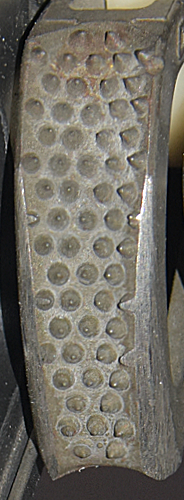 I acquired a pair of right-hand CMI Shorti, Version A ascenders in 2017 as part of Bob Thrun’s collection.
I acquired a pair of right-hand CMI Shorti, Version A ascenders in 2017 as part of Bob Thrun’s collection.
The CMI Shorti, Version A is 116 mm. tall, 76 mm. wide, 25 mm. thick, and weighs 160 g. It is identical to Version B except that the cam spring has a very long tail, as seen below the cam channel in the front view photo.
The only markings are "Cmi" in raised letters on
the cam, and a sticker that reads "The CMI Shorti."
Both of the ascenders in the pair are right-handed. I thought about converting one of them to a left-handed ascender, but for two reasons, I didn't:
- The spring is not reversible, and having it extend below the cam channel 15 mm. from the lower shell would be ridiculous. I was able to fabricate a left-hand spring from a spare CMI bent-tail spring, but decided not to use it for the second reason.
- The shell was milled for the cam rivet after anodizing. If I reversed the shell, the milled mark would make it obvious that the ascender was not original.
[ Top
| Shorti, v. A
| Shorti, v. C
| Shorti II, v. A
| Shorti II, v. B
| Shorti III, v.A
| Shorti III, v. B
| Shorti IV
| Optional Safety Kits
| Return to E.C. Ascenders
]
Shorti, Version B
(#4 & 5, 240, 2116)
Technical Details
The CMI Shorti came out with the CMI
5000 handled ascender. I obtained a pair of Version B from Speleoshoppe in
1979. I acquired an additional right-handed one from Sheryle Bauer in 2005 and another pair in 2017 as part of Bob Thrun’s collection, and installed optional safety pin kits on these.
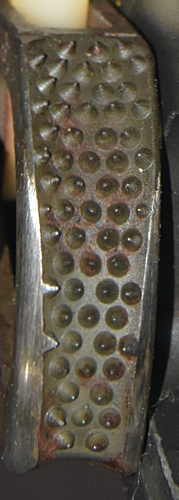 The pair consists of a left-handed and a right-handed ascender;
although the parts are designed symmetrically so that with proper
tools an ascender can be disassembled and reassembled to the opposite
handedness. Each ascender is 116 mm. high, 76 mm.
wide, 25 mm. thick, and weighs 175 grams. The shell
is milled from a custom aluminum extrusion and is extremely strong.
The shell body is 6.5 mm. thick and gray anodized. The U
shaped rope groove is 14.2 mm. in diameter. The cam mounting
groove is rectangular. Two cam pivot holes are provided; one for
the left and one for the right-handed configuration. The unused
hole allows using the optional safety kit discussed below. The
attachment holes are rounded 28.6x28.6 mm. right triangular
cutouts in the shell, with the resultant attachment lying outside
the cam attachment point.
The pair consists of a left-handed and a right-handed ascender;
although the parts are designed symmetrically so that with proper
tools an ascender can be disassembled and reassembled to the opposite
handedness. Each ascender is 116 mm. high, 76 mm.
wide, 25 mm. thick, and weighs 175 grams. The shell
is milled from a custom aluminum extrusion and is extremely strong.
The shell body is 6.5 mm. thick and gray anodized. The U
shaped rope groove is 14.2 mm. in diameter. The cam mounting
groove is rectangular. Two cam pivot holes are provided; one for
the left and one for the right-handed configuration. The unused
hole allows using the optional safety kit discussed below. The
attachment holes are rounded 28.6x28.6 mm. right triangular
cutouts in the shell, with the resultant attachment lying outside
the cam attachment point.
The cam is a skeletonized steel casting with a (2)(5.4)^4(3.4)^2(3.2)^2
conical tooth count. The teeth are fairly dull compared to those
of other toothed ascenders. The cam radius, measured from the
pivot, increases from 35 to 48 mm. over an angle of 48 degrees.
The cam pivot is a solid 6.4 mm. pin held by an external
retaining ring. The pivot is centered 49 mm. from the inside
of the rope groove. The cam safety is an elbow shaped lever mounted
on a roll pin in the cam. A single spring serves as cam spring
and safety spring. Normally this spring holds the safety where
it protrudes from both the top and bottom of the cam. The bottom
protrusion interferes with the shell’s cam channel and prevents
opening the cam. When the top of the lever is pushed towards the
cam teeth, the lower protrusion rotates into a recess in the cam,
thus allowing the cam to open.
The only markings are "Cmi" in raised letters on
the cam.
The shell on this ascender is very strong, but long ago a competitor
told me that the CMI cam was weaker than some of the competition’s.
Whether this is fact or biased opinion does not seem relevant, as I personally feel the CMI cam strength is more than adequate for
my purposes. The ascender can be opened with one hand, but the
safety is awkward, particularly when used in the "wrong"
hand. The location of the attachment points leads to substantial
ascender canting each time it is loaded; this results in some
efficiency loss while climbing. The ability to convert from left-handed
to right-handed configurations is a nice feature, but I recommend
that it not be done in the field since the small retaining ring
tends to become airborne if the proper tools are not available.
[ Top
| Shorti, v. A
| Shorti, v. B
| Shorti II, v. A
| Shorti II, v. B
| Shorti III, v.A
| Shorti III, v. B
| Shorti IV
| Optional Safety Kits
| Return to E.C. Ascenders
]
Shorti, Version C
(3468)
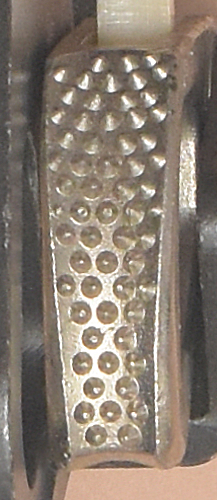 Technical Details
Technical Details
I acquired my CMI Shorti, Version C from Richard Morse in 2021.
Version C is 116 mm. tall, 76 mm. wide, 28 mm. thick, and weighs 166 g. The rope channel is 14 mm. wide. The cam pin is centered 47 mm. from the inside of the rope channel. The cam radius increases from 32 to 51 mm. over an angle of 48°, giving a 28° cam angle. The tooth pattern is (2)(5.4)^4(3.4)^2(3.2)^2.
Version C cams are plated. The channel for the cam safety has been enlarged
to accommodate a stronger cam spring, with the upper opening being shorter. The safety roll pin diameter
was increased.
The only markings are "Cmi" in raised letters on
the cam.
Unplated C.M.I. cams occasionally develop some minor rust. This is rarely an issue, but the cam plating helps prevent rusting.
The new cam safety channel provides additional reinforcement to the cam face.
[ Top
| Shorti, v. A
| Shorti, v. B
| Shorti, v. C
| Shorti II, v. B
| Shorti III, v.A
| Shorti III, v. B
| Shorti IV
| Optional Safety Kits
| Return to E.C. Ascenders
]
Shorti II, Version A
(#222, 3462)
Technical Details
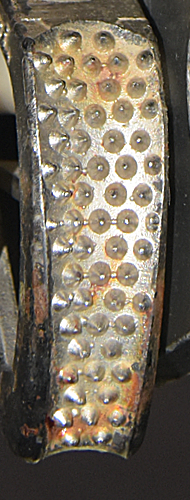 I acquired my CMI Shorti II, Version A from Charles Knowles in 2007.
It dates from about 1980, since it came out between the Shorti
and Shorti III that I acquired in 1979 and 1981, respectively. On Rope 1 donated another pair in 2021.
I acquired my CMI Shorti II, Version A from Charles Knowles in 2007.
It dates from about 1980, since it came out between the Shorti
and Shorti III that I acquired in 1979 and 1981, respectively. On Rope 1 donated another pair in 2021.
The CMI Shorti II, Version A is 116 mm. tall, 76 mm. wide, and 28 mm
thick. Mine weighs 168 g. The extrusion is the same as the
one used on the Shorti, but it is milled differently so that the
attachment openings are closer to the rope. The Shorti II
has a new cam design as well. The cam is a skeletonized steel casting
with a (2)(5.4)^4(3.4)^2(3.2)^2 conical
tooth count on the left-hand ascender and (3)(5.4)^4(3.4)^2(3.2)^2
on the right-hand one. Both cams have a reinforcing rod not seen
on the Shorti. This Shorti II cam is plated.
The only markings are "Cmi" in raised letters on
the cam, and a sticker which on each of mine is too faded to read.
I suspect that they read "The CMI Shorti" (not "Shorti II").
Apparently it did not take CMI long to realize that the shape
of the Shorti frame was a blunder. In effect, the Shorti II
frame looks like a mirror image of the Shorti. This relocates
the attachment points to where they can reduce ascender canting
to a minimum. A lesser change angles the top and bottom of the
rope channel. The rope runs over a right angled corner in the
Shorti, but the Shorti II changes these to obtuse angles.
The cam is probably stronger, but I don't notice a difference
in how it functions. Overall, the Shorti II is certainly
better than the Shorti - moving the attachment points is the key
improvement.
Judging by the stickers on some of these ascenders and literature that I have in my files, CMI may never have officially called this the Shorti II; however, this designation fits into the sequence in a logical fashion so I adopt it here.
[ Top
| Shorti, v. A
| Shorti, v. B
| Shorti, v. C
| Shorti II, v. A
| Shorti III, v.A
| Shorti III, v. B
| Shorti IV
| Optional Safety Kits
| Return to E.C. Ascenders
]
Shorti II, Version B
(#2095)
Technical Details
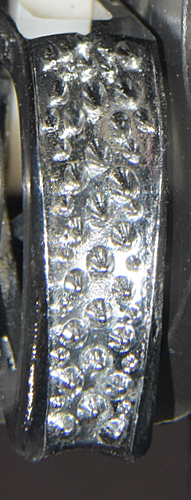 I acquired my CMI Shorti II, Version B in 2017
as part of Bob Thrun’s collection.
It dates from about 1980, since it came out between the Shorti
and Shorti III that I acquired in 1979 and 1981, respectively.
I acquired my CMI Shorti II, Version B in 2017
as part of Bob Thrun’s collection.
It dates from about 1980, since it came out between the Shorti
and Shorti III that I acquired in 1979 and 1981, respectively.
The CMI Shorti II, Version B is 116 mm. tall, 76 mm. wide, and 27 mm
thick. Mine weighs 176 g. The extrusion is the same as the
one used on Version A. The Shorti II, Version B has a new cam design. The cam is a skeletonized steel casting
with a (1.4.3.3.4)(3.2)^6 conical
tooth count. The Shorti II, Version B cam is also plated.
The only markings are "Cmi" in raised letters on
the cam, and a sticker that reads "the CMI shorti" (sic, not "Shorti II").
I don't notice a performance difference between the cams on Version A and Version B.
[ Top
| Shorti, v. A
| Shorti, v. B
| Shorti, v. C
| Shorti II, v. A
| Shorti II, v. B
| Shorti III, v. B
| Shorti IV
| Optional Safety Kits
| Return to E.C. Ascenders
]
Shorti III, Version A
(#6/7)
Technical Details
I acquired my CMI Shorti III, Version A from Pathfinder Sports around 1984.
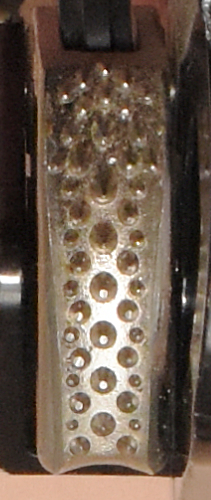 The CMI Shorti III came out with the CMI
5003 handled ascender. I obtained this pair from Pathfinder Sports
in 1981. At first glance it appears very similar to the CMI Shorti and shorti II,
but there are several significant differences. The pair consists
of a left-handed and a right-handed ascender; although the parts
are designed symmetrically so that with proper tools an ascender
can be disassembled and reassembled to the opposite handedness.
Each ascender is 120 mm. high, 79 mm. wide, 28 mm.
thick, and weighs 194 grams. The shell is milled from a revised
custom aluminum extrusion and painted black. The shell body is
6.5 mm. thick, and the rope channel is reinforced to 8.3 mm.
thick. The rope groove is larger (17 mm. in diameter) and
semicircular. The cam mounting groove is rectangular. Two cam
pivot holes are provided; one for the left and one for the right-handed
configuration. The unused hole allows using the optional safety
kit discussed below. The attachment holes are rounded 28.6x28.6 mm.
right triangular cutouts in the shell.
The CMI Shorti III came out with the CMI
5003 handled ascender. I obtained this pair from Pathfinder Sports
in 1981. At first glance it appears very similar to the CMI Shorti and shorti II,
but there are several significant differences. The pair consists
of a left-handed and a right-handed ascender; although the parts
are designed symmetrically so that with proper tools an ascender
can be disassembled and reassembled to the opposite handedness.
Each ascender is 120 mm. high, 79 mm. wide, 28 mm.
thick, and weighs 194 grams. The shell is milled from a revised
custom aluminum extrusion and painted black. The shell body is
6.5 mm. thick, and the rope channel is reinforced to 8.3 mm.
thick. The rope groove is larger (17 mm. in diameter) and
semicircular. The cam mounting groove is rectangular. Two cam
pivot holes are provided; one for the left and one for the right-handed
configuration. The unused hole allows using the optional safety
kit discussed below. The attachment holes are rounded 28.6x28.6 mm.
right triangular cutouts in the shell.
The cam is a plated skeletonized steel casting, with an internal
brace. The teeth are conical with a (1)(2.3)^2(4.3)(2.3)^5(2)
tooth count. The teeth axes are parallel to the upper surface
of the cam, and decrease in size towards sides of the cam. The
teeth are fairly dull compared to those of other toothed ascenders,
and the lower teeth had their points ground flat during manufacture,
probably unintentionally. The cam radius, measured from the pivot,
increases from 36 to 50 mm. over an angle of 48 degrees.
The cam pivot is a solid 6.4 mm. pin held by an external
retaining ring. The pivot is centered 47 mm. from the inside
of the rope groove. The cam safety is similar to the Shorti’s,
and functions in the same manner. The safety is molded plastic,
and the enlarged actuating lever lies along the top of the cam
rather than sticking up from the cam. The roll pin is larger than
in the Shorti. A single spring serves as cam spring and safety
spring.
The only markings are "Cmi" in raised letters on
the cam, and a sticker that reads "shorti III" and "Cmi."
The ascender is moderately well made, although the cam teeth
were carelessly damaged by the manufacturer. Orienting the cam
teeth axes parallel to the top of the ascender cam is an improvement.
This design gives the teeth a slight downwards alignment with
respect to the climbing rope. This increases their grip, reduces
tooth friction while raising the ascender, and provides a small
self cleaning action at the same time.
The ascender can be opened with one hand, but the safety is even more awkward than on the Shorti. I suspect that the new
design was developed to reduce the risk of accidentally opening
the ascender, but I don't find this to be a problem. In any case,
the correct way to prevent accidental opening is to install the
optional safety kit. CMI should have rounded the insides of the
triangular attachment holes.
[ Top
| Shorti, v. A
| Shorti, v. B
| Shorti, v. C
| Shorti II, v. A
| Shorti II, v. B
| Shorti III, v. A
| Shorti IV
| Optional Safety Kits
| Return to E.C. Ascenders
]
Shorti III, Version B
(#2923)
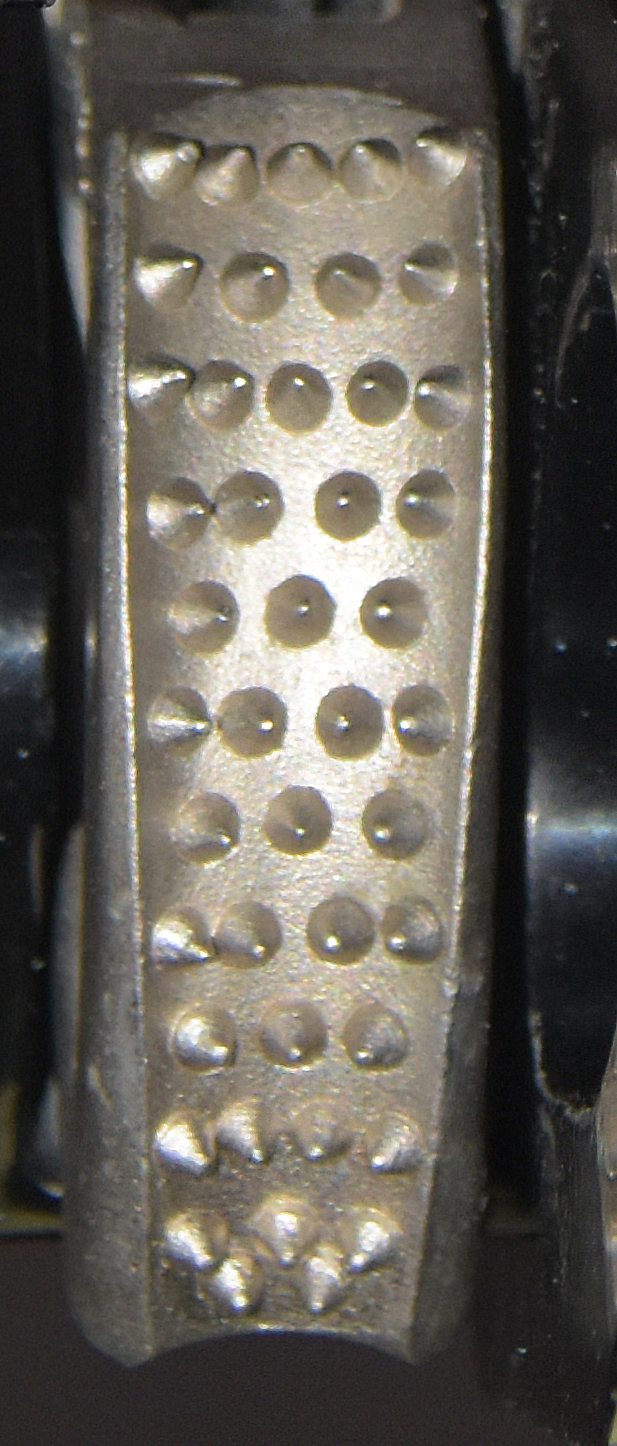 Technical Details
Technical Details
I acquired my CMI Shorti III, Version B from Irvin Stickell in 2019.
The CMI Shorti III, Version B is 120 mm. tall, 76 mm. wide, 28 mm. thick, and weighs 187 g.
This version of the Shorti III uses a cam with a different tooth pattern, specifically (5.4)^2(3.4)^3(3.2). Aside from this, it is identical to my CMI Shorti III, Version A.
The only markings are "Cmi" in raised letters on
the cam, and a sticker that reads "shorti III" and "Cmi."
I do not notice any difference between the performance of the Version A and Version B cams. This cam was also used for the CMI Shorti IV and 5004 ascenders.
[ Top
| Shorti, v. A
| Shorti, v. B
| Shorti, v. C
| Shorti II, v. A
| Shorti II, v. B
| Shorti III, v.A
| Shorti III, v. B
| Optional Safety Kits
]
Shorti IV
(#8, 1508, 2072, 3463)
Technical Details
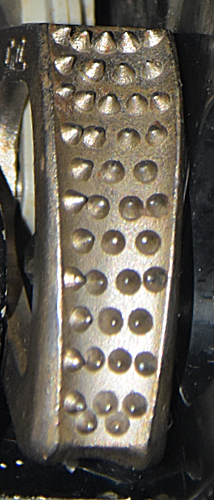 The CMI Shorti IV came out with the CMI
5004 handled ascender. I acquired one pair from Inner Mountain Outfitters in 1989 and a second used pair on eBay from James Lucchesi in 2009. I acquired another pair in 2017 as part of Bob Thrun’s collection, and installed an optional safety pin kit on that pair. On Rope 1 donated another pair in 2021, which I then donated to Artyom Babin (Артём Бабин).
The CMI Shorti IV came out with the CMI
5004 handled ascender. I acquired one pair from Inner Mountain Outfitters in 1989 and a second used pair on eBay from James Lucchesi in 2009. I acquired another pair in 2017 as part of Bob Thrun’s collection, and installed an optional safety pin kit on that pair. On Rope 1 donated another pair in 2021, which I then donated to Artyom Babin (Артём Бабин).
The cam is the same as the one on later Shorti IIIs.
The safety has a notch in it that serves no function, and the
plastic appears to be harder than on the Shorti III.
The only discernible difference between the frame of this ascender
and the Shorti III is in the rope channel design. The Shorti IV
rope channel extends farther towards the cam pivot and has a small
lip inside.
In 1986 C.M.I. issued a press release noting that "under
some unusual circumstances [the C.M.I.] 5003 and Shorti III ascenders can be forced off the rope." It is possible
to get some thinner, soft lay ropes to pull out between the cam
and the side of the rope channel if one works at it a while, but
I have been completely unsuccessful in pulling 11 mm. P.M.I.
Pit Rope out of my pair of Short IIIs under any reasonable circumstances. There
is no doubt that the Shorti IV provides a more rope security
than the III, but I have no practical worries that would keep me from using either version.
[ Top
| Shorti, v. A
| Shorti, v. B
| Shorti, v. C
| Shorti II, v. A
| Shorti II, v. B
| Shorti III, v.A
| Shorti III, v. B
| Shorti IV
| Return to E.C. Ascenders
]
Optional Safety Kits
(#1928, 2320)
Technical Details
I purchased one "Optional Safety Kit" from Pathfinder
Sports ca. 1980 and not long after acquired another. In 2017 I acquired several additional kits and loose pins from Bob & Bob.
CMI manufactured an "Optional Safety Kit" for the
CMI Shorti ascender. The kit adds 11 grams to each ascender,
and increases the width to 37 mm. Each kit contains pins for a pair of ascenders. I have two versions:
- Version A consists of a new cam pivot pin with a pull pin attached by 1.7 mm. stainless steel cable.
The other end of the cable has a crimped finger loop with a check pin attached.
- Version B replaces the cam pivot pin in Version A with an eyelet crimp (essentially an electrical wire crimp). This kit included replacement cam pins that were long enough to provide clearance for the eyelet.
Simple instructions describe how to install the kit. Once installed,
the check pin can be inserted through the unused pivot hole in
the ascender shell from back to front. The pin will then prevent
the cam from opening. The finger loop in the cable provides a means
of gripping the pin firmly for removal.
The safety pin substantially reduces the chance of the cam
opening accidentally. It does not interfere with the normal safety,
so both must be overridden for the cam to open. On the other hand,
the optional safety kit adds extra steps to common procedures
such as passing knots or rebelays, so I do not use it.
I've installed safety pin kits on the following ascenders:
Shorti, Version A with Version A Pin Kit:
Although these photos show the Version A kit, the Version B kit would also fit.
Shorti II, Version B with Version A Pin Kit:
Either version of the Pin Kit fits on any of the Shorti ascenders in my collection, although the fit is a bit tight for Version A.
Shorti III with Version A Pin Kit:
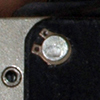 The paint on the Shorti III makes it difficult to use the Version A kit - the distance from the head of the cam pin to the retaining ring groove is not quite long enough. On the other hand, Version B kit fits quite well.
The paint on the Shorti III makes it difficult to use the Version A kit - the distance from the head of the cam pin to the retaining ring groove is not quite long enough. On the other hand, Version B kit fits quite well.
I'm showing the Shorti III with Version A kit to illustrate a potential problem. A close look at these photos shows that the retaining ring is sprung from the tight fit, and is barely seating in the groove.
|
 |
Warning:
If the retaining ring is not fully seated, it can easily come off,
allowing the cam pin to back out.
This will either cause the ascender to jam,
or possibly come aparT. |
 |
|
| |
|
 |
I am looking for a pair of Shorti IIIs that I can display with one of my Version B pin kits attached.
If you have a pair that you are willing to part with, please
email me. |
|
| |
Shorti IV with Version B Pin Kit:
The paint on the Shorti IV makes it difficult to impossible to use the Version A kit - the distance from the head of the cam pin to the retaining ring groove is not long enough. On the other hand, Version B kit fits quite well, as the photos show.
Unfortunately, the eye crimp used in the Version B kit bends easily, and repeated bending will cause it to fatigue and fail. Of course, the user can simply replace it with a new crimp, easily found at any decent hardware store. The design used in the Version A kit is far more robust.
[ Top
| Shorti, v. A
| Shorti, v. B
| Shorti, v. C
| Shorti II, v. A
| Shorti II, v. B
| Shorti III, v.A
| Shorti III, v. B
| Shorti IV
| Optional Safety Kits
| Return to E.C. Ascenders
]



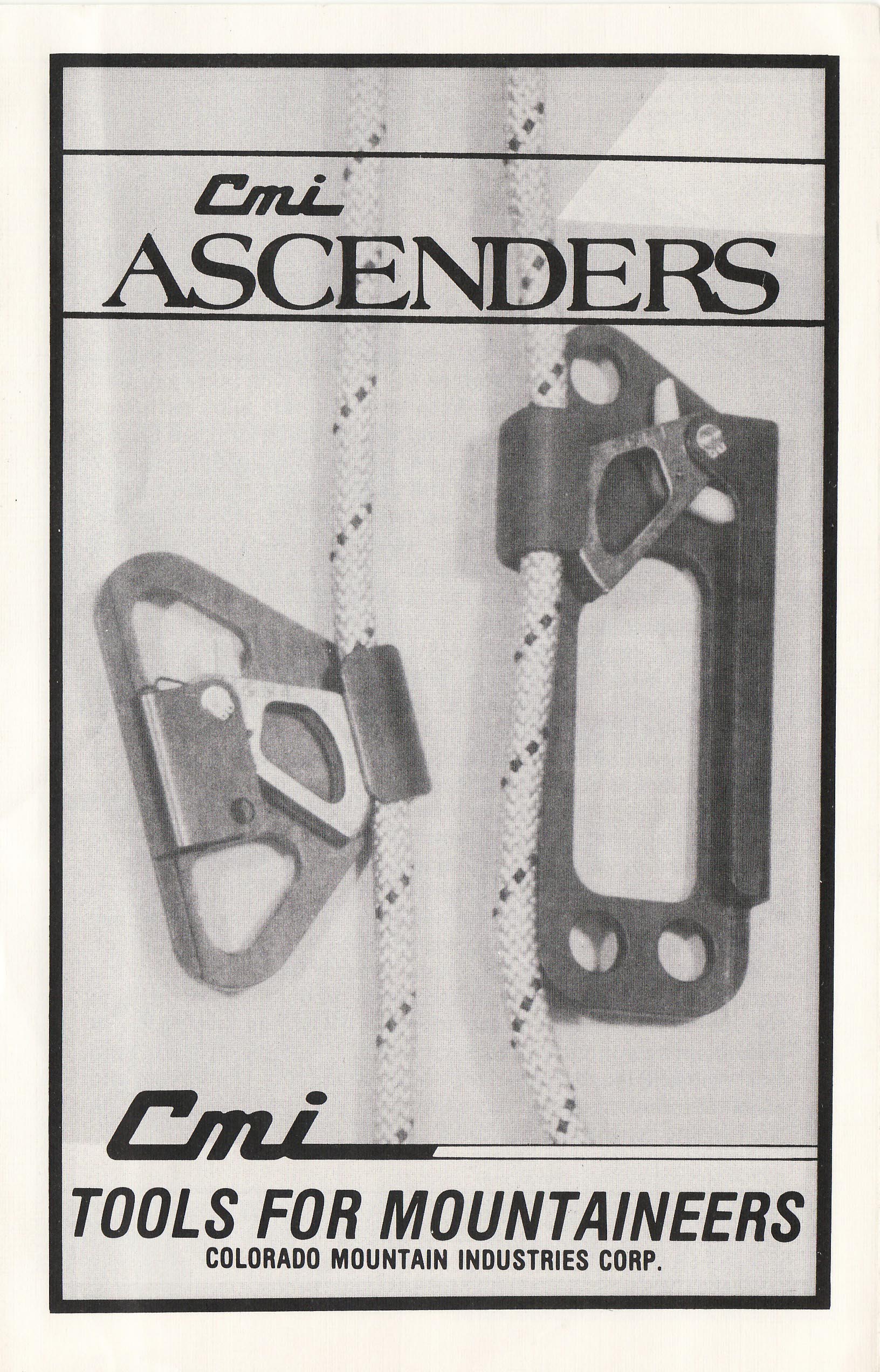
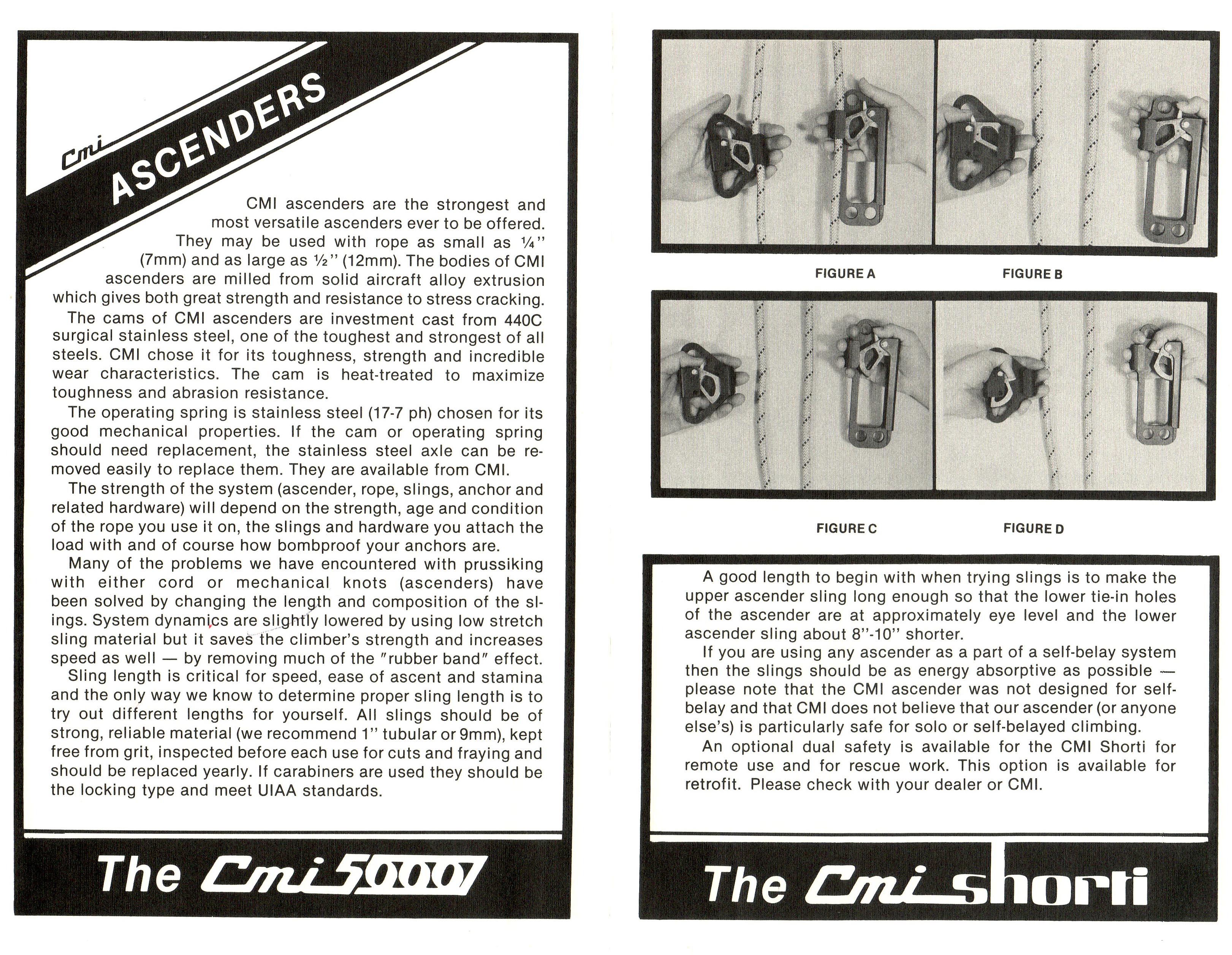
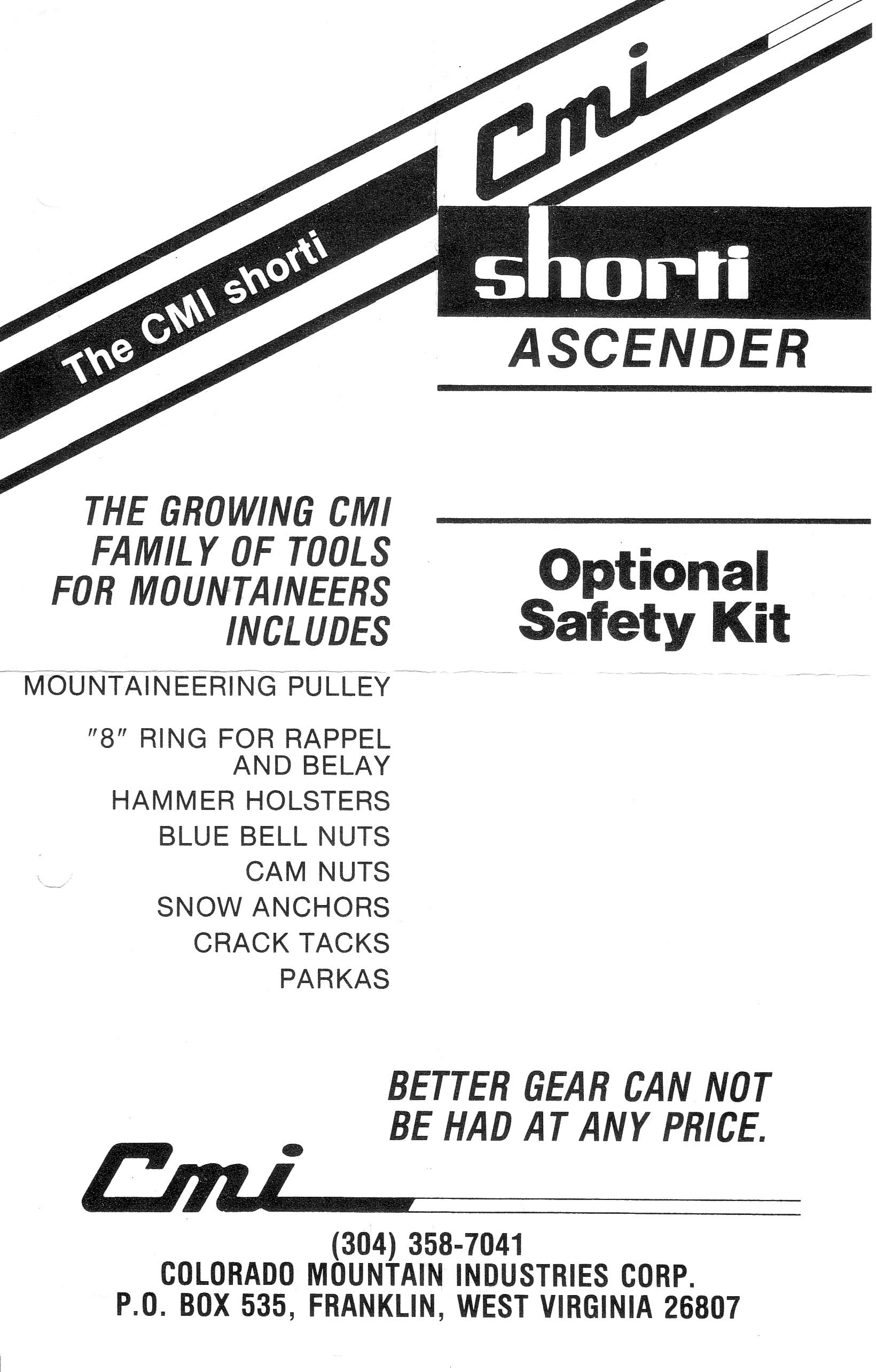
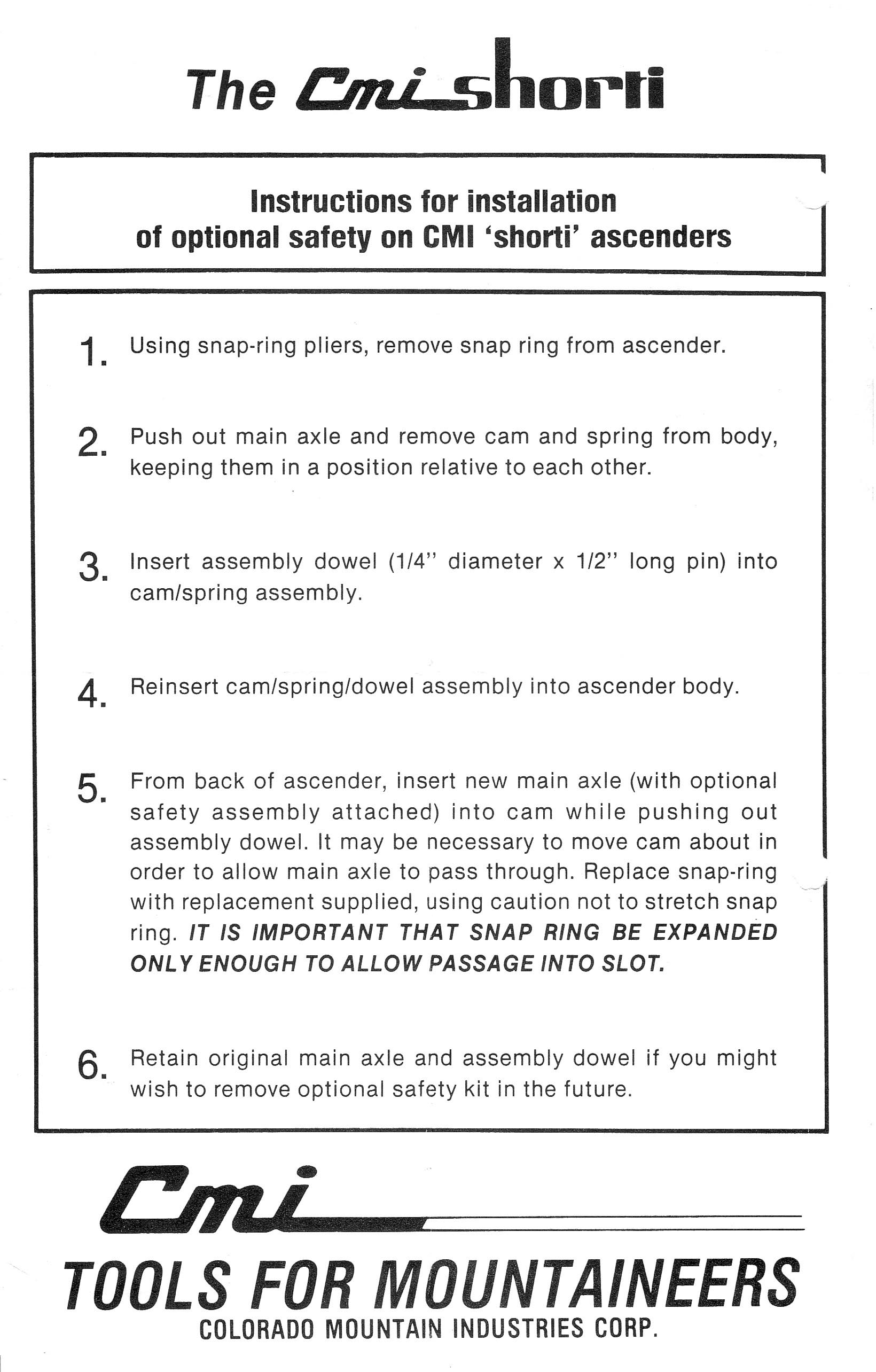
 The paint on the Shorti III makes it difficult to use the Version A kit - the distance from the head of the cam pin to the retaining ring groove is not quite long enough. On the other hand, Version B kit fits quite well.
The paint on the Shorti III makes it difficult to use the Version A kit - the distance from the head of the cam pin to the retaining ring groove is not quite long enough. On the other hand, Version B kit fits quite well.